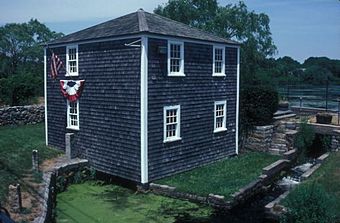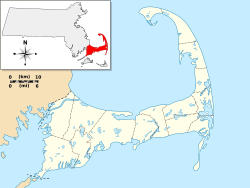Baxter Mill facts for kids
Quick facts for kids |
|
|
Baxter Mill
|
|

Baxter Mill
|
|
| Location | MA 28, West Yarmouth, Massachusetts |
|---|---|
| Built | 1710; expanded 1860; restored 1961 |
| NRHP reference No. | 81000120 |
| Added to NRHP | August 27, 1981 |
The Baxter Mill is a very old building in West Yarmouth, Massachusetts. It's a special kind of mill called a gristmill. This means it used to grind grain, like corn, into flour. Built around 1710, it's the only water-powered mill from the 1700s still standing on Cape Cod. Today, it's a fun museum where you can learn about its history. The town owns it, and the Yarmouth Historical Commission helps run it. The mill was added to the National Register of Historic Places in 1981.
Contents
Exploring the Baxter Mill
The Baxter Mill is located in West Yarmouth. You can find it on a narrow piece of land. This land is between Massachusetts Route 28 and Mill Pond. It sits between Baxter Street and Mill Pond Road.
What the Mill Looks Like
The mill is a small, two-story building. It is made of wood and is about 20 feet (6 meters) square. The roof is shaped like a hip roof, and the outside is covered with shingles. There's a low stone wall on the north and east sides. You can also see a stone-lined channel where water flows out of the pond.
A Look at the Mill's History
The Baxter Mill was built around 1710. It was built by two people named John and Shubel Baxter. When it was first built, the mill used a waterwheel on the outside. This type of wheel was common back then. However, it could get damaged in cold winter weather.
How the Mill Changed Over Time
In 1860, the mill was updated. The old outdoor waterwheel was replaced. A new internal turbine was put in instead. A turbine is like a special wheel that spins inside. This change helped the mill work better. The mill kept grinding grain until the early 1900s.
Bringing the Mill Back to Life
In 1961, the mill was carefully restored. This means it was fixed up to work again. As part of the restoration, a new turbine was made. It was a copy of the one from 1860. The original 1860 turbine is still there today. You can see it as part of the museum display. The mill was given to the town of Yarmouth. Now, the Yarmouth Historical Commission runs it as a museum. It is open to visitors during certain times of the year.
See Also




